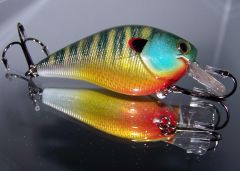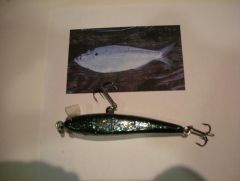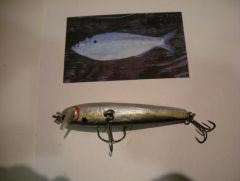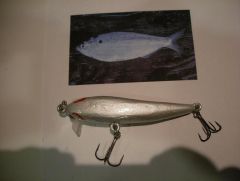-
Posts
14,726 -
Joined
-
Last visited
-
Days Won
364
Content Type
Profiles
Articles
TU Classifieds
Glossary
Website Links
Forums
Gallery
Store
Everything posted by mark poulson
-
I have a piece of dense foam board mounted to a piece of plywood, like an eisel, and drape the scale cloth over the lure, which is suspended between two rows of screws, one on each side. I use an opened paper clip in each end, and a rubber band from one clip to a screw to provide tension. That way, I can paint different length lures and just adjust the rubber band. I form the cloth over the lure, and use push pins to attach the cloth to the foam and provide a tight fit. I play around with pin placement until I get the cloth to conform to the lure's shape. I only do one side of a lure at a time, but it works really well for jointed baits. I've found that the cloth is a little stiff the first time I use it, but a coating of Createx, heat set, seems to make it much softer.
-
I mix paint in salsa solo cups that I save when I get Mexican food. They come with lids. I wash them out with hot water and dishwashing liquid, and they're ready for paint. Not perfect, but cheap, and will keep paint for a week or so before it dries out.
-
That looks like a perfect candidate for a Lucite tail. It's thin, hard, and strong, and can be machined/cut with wood working tools. It will click and clack, and you can find it at home depot. I haven't used it for tails, just bills, so I don't know if it can be colored. If you want to add color, use the dividers from a large Plano 3700 box. Not quite as hard, so there won't be the same click/clack, but they take color from sharpies really well. I use sand paper to grain the pastic before I add the sharpie colors, to give the color something to bite into. If you want a thinner tail section, you can use the clear tops from quacamole tubs for the tails.
-
I've used their fluorescent orange for bluegill accents, and they haven't faded so far. Some of my baits with that paint are over two years old.
-
-
3 1/4", 12 grams, PVC, no ballast added, Createx, sharpies, NYC 101 nail polish, SC 9000 three dip coats. The body shape is a copy of a "cheap" Megabait walking bait that works real well. The lure sits slightly tail down, but almost level at rest. The bill is set at 30 degrees to square, so the bait twists 90 degrees on the pull, and then rotates back upright on the pause. The belly of the lure has one side of a shad scheme, so it looks like a stunned shad on it's side at rest. I made it this small to use on early season busters, but I'll make a bigger one for later on, when the shad are bigger.
-

Looks Like Netbait Filed Suit To Enforce Its Patent
mark poulson replied to Acuna's topic in Soft Plastics
The longer it takes, the more $ the lawyers make. -
Desert Bass, I use 1/4" lead wire that I bought from Cabelas for weighting my jointedswim baits. 1/8"=1 gram+-. Fits a 1/4" hole perfectly. I cut it with an exacto knife, and roll it afterward between my saw table and a flat piece of steel to even out the mushrooming caused by the knife. When I used poplar, I would shape and predrill all the hardware and hinge holes, drill holes in the head and second section for possible ballast, and seal. Then I'd assemble and float test with the hooks installed. I'd add lead sinkers to the front treble tines until I got the lure to sit, or sink, like I wanted, weight the sinkers I had used, and then cut off that much lead wire. Because ballast kills swimming action, I would add most of the ballast to the front section, and only put some in the second section for sinkers. Any ballast holes I didn't use I'd fill with paper towel, add a drop of crazy glue, and then bondo over them to seal them. I found that I wanted to weight the baits so they sat level in the water, or dove slightly head first on the fall. That way, the tail would float up and keep the lure horizontal on a slow, deep retrieve. Mike, First of all, you baits look great! They should get clobbered. Have you tried the plastic netting that avacados come in at the market, and the netting from oranges? Both are diamond shaped. I actually got a really neat effect by first putting regular tule netting over the bait, and then the avacado netting.
-
BobP said, "Monkey see, monkey do". Nuff said!
-
This view is the bottom of the lure when it's at rest. The hook hanger is hanging straight down at rest, and the bill is rotated to one side, so it spills water when it gets the bait rotated 90 degrees+- so the belly scheme is down. On the pause, it rolls back to the bottom down position. I don't know if it will catch fish, but it was fun to make.
-
Bassrecord on the hard baits forum asked about a bait the flips from belly to back, like a dying baitfish. I thought this would come close. It has a side to belly action, and then returns to it's side. It's actually just that the paint scheme is shifted 90 degrees. I made a conventional, Sammie-type walking bait, cut a bill into it at approx. 30 degrees from square, so it acts like a screw on the pull and rotates the bait 90 degrees. I weighted it so it's slightly tail heavy, but not hanging down like a Sammie, so at rest it looks like a bluegill on it's side, and then rotates to belly down. 4", 27 grams, 3/4" wide X 5/8" deep, 3 grams ballast at 3"+-, PVC, Createx, SC 9000 three coats dipped. It works in the bath tub. My rubber duckie is jealous. Fingers crossed when I take it out for a swim Saturday.
-
I made a 4" bluegill yesterday that turns from it's side to it's belly on the retrieve in the bath tub. I am going to take it out Saturday for a test drive. I suspect there will be a learning curve to get it to have a struggling fish action. I'm going to post (4) pictures of it in the gallery. I made a wide, thin prototype with a belly weight, and several bill slots, and experimented with that first. I finally deduced that making the lure with a Sammie-type body, and adding the bill on about a 30 degree angle would give me the screw down motion I needed to get a side to belly roll. I painted the back and the belly with the side profile of the bluegill, so it would look like a baitfish on it's side at rest, and roll onto it's belly on the pull. Check out the pictures. They say it best.
-
Dieter, Now you've done it! I have been inspired by your lure work to try artificial cork for lures again. So I am planning to make a dozen prototypes. Of course, this will involve buying 12 bottles of wine. And, to insure that they aren't wasted, I won't be able to use the corks for lures until each bottle is empty, so you can see I have my work cut out for me. I would set a time table for actually starting the lure making, but the process of "bottle preparation" seems to actually delay the lure making process. Thanks again for sharing all your wonderful ideas.
-
What's that called, the Tree Pounder Magnet? As I said in the first line of my post, "I see nothing wrong with buying, painting, and reselling unpainted cranks that are knockoffs of other baits if you're up front with what they are". Anyone who can actually duplicate the original will have to go through the same building processes, incur the same costs, and have to charge just as much as the original builders, so there would be no savings in buying the knockoffs. Cheap copies are just that, cheap copies. They work sometimes, in some situations, but are not the same as the originals. As long as you know going in that it's a knockoff, it's you choice.
-
That is some scary stuff. When nitrocellulose lacquer was used by everyone, we used to think it was great to get a buzz from the fumes when the painters sprayed the cabinets on a job. I had no idea how bad it was for us, until I almost passed out on a commercial job, and had to be helped outside so I could breathe clean air. As it was, I had to sit for half an hour before I could walk without falling down. Solvent fumes are nothing to fool around with, especially with today's catalyzed finishes.
-
I see nothing wrong with buying, painting, and reselling unpainted cranks that are knockoffs of other baits if you're up front with what they are. On Predator Bass, Jim is very clear to say "Similar to a LC RC 2.5" or to whatever the particular bait is made to simulate. I can respect that. You know what you're buying, and you have the choice to buy it or not. As long as you're not reverse engineering a lure, and making exact copies, I don't think it's wrong, even if you're selling them. When I first started making jointed lures, I used photos of the Triple Trout to give me a starting point. I learned about weighting, joints, and body shape through trial and error, and that has helped me make lots of other baits that work since then. I've sent guys on this site detailed construction drawings for making baits like mine, which I do sell, and have no problem with them making their own, and selling them under their own name. I know everyone's baits are different, and no one is going to retire on the money they make selling hand made baits, so I just figure it's all good. I asked Bill Siemantel, who had just released the BBZ 1 8" trout, for some advice on whether I was doing anything wrong, and he said, "Hell, no. We all are copying baits that were made before." He's been involved with the development of almost every successful west coast swimbait for the last 20+ years, so I take his word for it.
-
Well, you've solved the top coat problem! Your inventive mind never ceases to amaze me! If winter lasts too long, you'll have to get a bigger place to store all the lures you're making. How are you attaching you hook hangers? I made a popper with one of the artificial corks, and was surprised at how difficult it was to get a finished shape with one. For me, it didn't tool well. I would suggest trying the expanding foam in the spray cans, too. The foam I get here expands to three times it's initial volume, is waterproof, sticks well to metal, and is easy to shape once it's set, in about three hours. I think it will be even more buoyant than the artificial corks. Once you've sprayed some foam, you can clean out the spray nozzle and the top of the can with acetone, and it's usable again. We do that so we don't waste a can when we only need a little.
-
I sand the blank smooth first, then drip on the crazy glue, usually Zap brand. It's pretty easy to put on small amounts, and watch them run down and soak in. I usually put the tip of the glue bottle right onto the blank, and use the blank to control how much glue comes out. If it's not smooth when I'm done, I wet sand it. After I add paint and top coat, it's smooth anyway. I don't prime my balsa baits once I've sealed them with crazy glue. And my paint bonds just fine. I just made a PVC lure that I wanted to fish the next day. I got it ready to paint, wet sanded it, and painted it without primer. The surface looked slightly pitted after the paint, but it's totally smooth after three dips in my urethane top coat. I made the lure Friday, and fished it yesterday, and it worked just fine. No issues with the paint, or the top coat. Of course, it's a two piece floater with a bill that runs down to 3', at the most, so I didn't hit any rocks with it. I did drop in on my driveway (by accident) when I was putting it in my boat, and there was not damage. Try a test and see if you find that to be true for your baits, too. It cut out a day in my lure making process, because I used to use rattle can primer that needed to dry/offgas overnight. My Createx paint bonded very well to the PVC. I think heat setting it softened the PVC a little and helped it bond.











